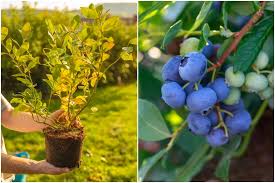Rhododendrons, Dogwoods, Holly, Mountain Laurel, and a host of other plants make ideal companions for blueberries. This article explains why they’re great companion plants for blueberries. Rhododendrons and Dogwoods, for example, attract predatory wasps, which don’t sting humans. Companion planting is a low-maintenance way to add a beautiful landscape to your yard.
Companion Planting With Blueberries
Rhododendrons
If you want to grow a variety of plants that look good together, consider rhododendrons. Both thrive in similar conditions and have beautiful, fragrant flowers that attract beneficial insects and pollinators. You can also add azalea or heathen ground cover to your garden. Both of these plants prefer acidic soil and have similar nutrient requirements. Heather grows in shady areas and is an excellent companion plant for blueberries.
Another good companion plant is basil. Basil grows in moderately acidic soil and grows to about 2 feet. It has attractive violet flowers and can be used as a flavoring in hundreds of recipes. This plant is also beneficial for attracting bees, which will pollinate your blueberries. Basil is another perennial plant that will thrive with blueberries in your garden. It can also be grown in containers.
Dogwoods
Red twig dogwood is an excellent companion shrub for boggy areas. Depending on cultivar, red twig dogwoods can grow three to eight feet tall. They prefer moist, sunny conditions. Some species are also suitable as a companion plant for blueberries. In addition to dogwood, other shrubs that go well with blueberries include winterberry hollies, summersweet, and Aronia arbutifolia.
Azaleas, columbine, and dogwoods have similar soil and growing conditions and make ideal companion plants for blueberries. They have lanky, delicate foliage, and their blooms complement blueberries. Dogwoods also tolerate acidic soil and are great companion plants for blueberries. You can plant these shrubs in shady locations for optimal growth. Azaleas are another low-maintenance companion plant for blueberries. Their flowers are a bright red color and attract pollinators and beneficial insects.
Holly
A beautiful plant that grows well in the shade, holly can be planted near or in the vicinity of blueberries. Unlike blueberries, which require full sun, hollies prefer an acidic or neutral soil pH. Depending on the species, they can be paired with blueberries. The male holly is known as ‘Blue Prince’, while the female cultivar is called ‘Blue Princess’.
The two plants are similar in their needs and management, and their leaves are attractive to both humans and pets. But the differences are in the details, such as pests and diseases. Here are some common problems you might encounter with your Holly plants:
Mountain Laurel
If you’re planning a garden with blueberries and mountain laurel, you’re in for a treat. Not only is this perennial native to the east coast, but it’s also the state flower of Connecticut. Mountain laurel grows in dense thickets in eastern US forests, where it’s associated with bushwhacking conditions. But it’s a lovely addition to your landscape, too!
As a member of the Ericaceae family, mountain laurel forms a symbiotic relationship with fungi in the soil. They provide plants with increased soil accessibility and produce enzymes that release organic nitrogen. These fungi favor mountain laurel, and they are important to the forest’s biodiversity. Because these plants share a common phylogenetic link, they’re often planted together.
Nasturtiums
Planting Nasturtiums near your blueberries will provide some of the benefits of both crops. Nasturtiums attract pollinators and are a good repellent for aphids. The leaves are highly aromatic and can deter flea beetles and onion flies. Nasturtiums also attract beneficial insects, such as ladybugs and hoverflies.
You can harvest the seeds of Nasturtiums from their withered flower heads by tapping the stem. The small, round seeds will drop out. If you freeze them, their fertility will be lost, and they may not germinate. Alternatively, you can store them for a couple of years. This will help ensure you have an abundant supply of seeds the following spring. To make seeds last as long as possible, wait until the nasturtiums flower to set seed.
Heather
There are many ways to plant heather in your yard. This plant needs a good drainage system and should be grown in soil that is a bit acidic. If you grow heather in pots, be sure to plant them in a deep hole. You can also plant them from cuttings. Heathers need at least six hours of sunlight per day. Heathers also grow well in containers, especially if they get a lot of sun.
Heathers are great ground cover, rock garden plants, and border plants. Heathers grow best in USDA Growing Zones 5 to 8 and are increasingly being released in a wider range of climates. One such cultivar, E. arborea var. alpina ‘Albert’s Gold’, has beautiful white flowers in winter. Heather plants companion plants with blueberries
